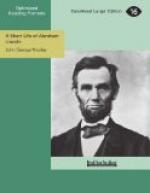The first obstacle to be overcome was the fire from the twin forts Jackson and St. Philip, situated nearly opposite each other at a bend of the Mississippi twenty-five miles above the mouth of the river, while the city of New Orleans itself lies seventy-five miles farther up the stream. These were formidable forts of masonry, with an armament together of over a hundred guns, and garrisons of about six hundred men each. They also had auxiliary defenses: first, of a strong river barrier of log rafts and other obstructions connected by powerful chains, half a mile below the forts; second, of an improvised fleet of sixteen rebel gunboats and a formidable floating battery. None of Farragut’s ships were ironclad. He had, from the beginning of the undertaking, maintained the theory that a wooden fleet, properly handled, could successfully pass the batteries of the forts. “I would as soon have a paper ship as an ironclad; only give me men to fight her!” he said. He might not come back; but New Orleans would be won. In his hazardous undertaking his faith was based largely on the skill and courage of his subordinate commanders of ships, and this faith was fully sustained by their gallantry and devotion.
Porter’s flotilla of nineteen schooners carrying two mortars each, anchored below the forts, maintained a heavy bombardment for five days, and then Farragut decided to try his ships. On the night of the twentieth the daring work of two gunboats cut an opening through the river barrier through which the vessels might pass; and at two o’clock on the morning of April 24, Farragut gave the signal to advance. The first division of his fleet, eight vessels, led by Captain Bailey, successfully passed the barrier. The second division of nine ships was not quite so fortunate. Three of them failed to pass the barrier, but the others, led by Farragut himself in his flag-ship, the Hartford, followed the advance.
The starlit night was quickly obscured by the smoke of the general cannonade from both ships and forts; but the heavy batteries of the latter had little effect on the passing fleet. Farragut’s flag-ship was for a short while in great danger. At a moment when she slightly grounded a huge fire-raft, fully ablaze, was pushed against her by a rebel tug, and the flames caught in the paint on her side, and mounted into her rigging. But this danger had also been provided against, and by heroic efforts the Hartford freed herself from her peril. Immediately above the forts, the fleet of rebel gunboats joined in the battle, which now resolved itself into a series of conflicts between single vessels or small groups. But the stronger and better-armed Union ships quickly destroyed the Confederate flotilla, with the single exception that two of the enemy’s gunboats rammed the Varuna from opposite sides and sank her. Aside from this, the Union fleet sustained much miscellaneous damage, but no serious injury in the furious battle of an hour and a half.




